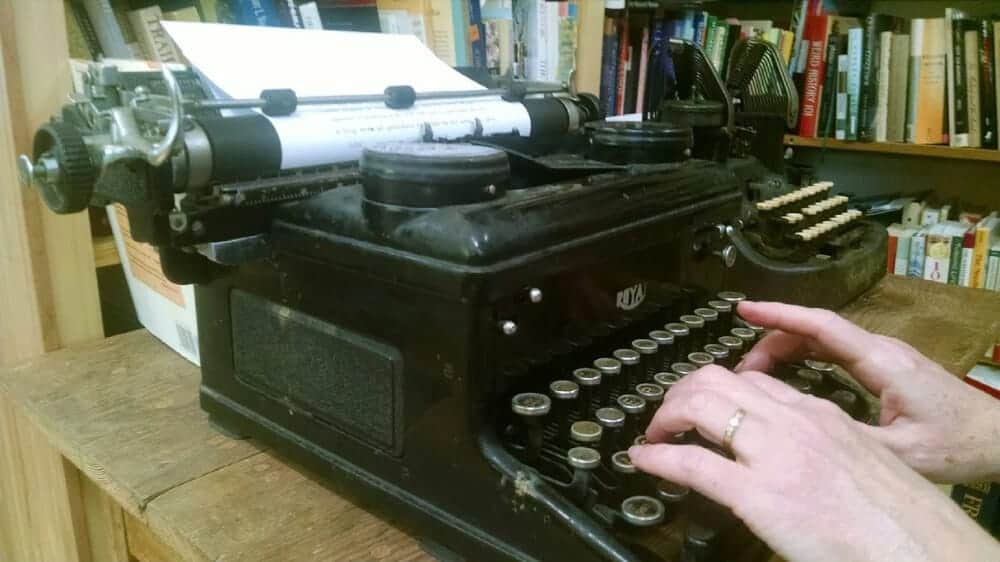A Writer with Multiple Sclerosis Finds Unexpected Gratitude with an Antique Typewriter
The following post is part of our series on perspectives from disabled and chronically ill people regarding COVID-19.
“Not another typewriter!”
When my husband J.P. held open the box delivered by U.P.S. to reveal his latest acquisition, I lost it. As a neat freak, nothing sends me into a tizzy faster than clutter. But since the coronavirus quarantine, the sight of J.P. happily tinkering with his 1917 L.C. Smith & Brothers machine stirred an unexpected wave of gratitude.
The quarantine all too easily reminded me of what we didn’t have. Sunday services at our church were on hiatus, the spring library book sale wouldn’t happen at all, and our paper towel supply was dwindling fast, but the slow and steady rhythm of those old-fashioned keys oddly soothed me. How fortunate we were to have a one-of-a-kind collection of typewriters actually used by people who faced their own trials, including both World Wars, the 1918 Influenza Epidemic, the Great Depression, and more.
We all have our battles. I’m a twenty-year warrior of multiple sclerosis (M.S.), a disease that occurs when the immune system attacks the protective coating of the nerves. Symptoms vary, but I suffer primarily from weak legs and chronic fatigue. Monthly infusions of a special medication help abate exacerbations by suppressing my immune system. This makes me particularly vulnerable to communicable diseases even in the best of times, so a self-imposed quarantine right now could easily be the difference between life and death for me.
As my M.S. progressed through the years, it began to take much longer to assemble my thoughts. The computer, for all its innovations, wasn’t helping. I could type over 60 words per minute on my laptop without once thinking about line breaks. With auto-correct I didn’t even have to worry about misspelled words or basic grammar. This might be a blessing for most writers, but it wasn’t the case for me. The ease of executing perfect sentences brought out my inner critic and stifled the serendipitous flow of ideas and connections. I prefer writing poems on paper for this very reason. To give my right brain permission for creativity on longer works such as essays and short stories, I desperately needed a tool that better matched the pace of my thinking. “You ought to use a typewriter,” J.P. had often said, but I was always too busy. Now, courtesy of the quarantine, I had all the time in the world.
As I sampled the various machines in his collection, I felt like Goldilocks. The fit had to be just right. The keys on the 1917 L.C. Smith & Brothers model were far too deep for my short fingers. Even so, the smooth glass-topped keys felt nothing short of luxurious after years of typing on a plastic keyboard. I liked where this adventure was going.
Next, I simply had to try the 1919 Oliver #9 Standard Visible Writer, one of the most unusual machines I’d ever seen. Its twin columns of type bars, much like the ears of a bat, gave the machine a comical air. Unfortunately, the typewriter lacked a top for the “d” key, and it hurt my finger too much to tap the naked lever. But the curly-cued serifs of its typeface melted my heart, as did the gentle tinkle of the bell as I approached the margin. It was less a rebuke than an Atta girl!
The beige 1950s Smith-Corona Portable Electric (manufactured after L.C. Smith & Bros. merged with the Corona Typewriter Company) reminded me of the typewriter I’d first used in high school typing class. The motor’s salubrious hum eased my mind, as if a muse waited patiently for me to compose my thoughts. And every once in a while, I heard the voice of Mrs. Ledwell, my eleventh-grade typing teacher. Keep your fingers on the home keys.
The height and feel of the keys on the black-lacquered 1936 Royal KHM perfectly suited Goldilocks, and the pace between keystrokes gave me just enough time to choose my next word. It helped that I couldn’t find the hyphen on this machine, because the mark on that particular key (a dim little line beneath the asterisk) was obscured by age. I suddenly realized how much I’d overused that poor little punctuation mark. Now, rather than overloading one sentence with multiple ideas and artificially linking them with a hyphen, I was forced to concentrate on one idea and one sentence at a time. You might notice that this essay, which was first typed on the Royal, contains no hyphens at all.
Typing is a mindful journey. I could never type more than 35 words per minute on even the Smith-Corona, but when it comes to writing, it’s not about the speed. Adjusting for characters I couldn’t easily find (like the hyphen) led to new ways of thinking well worth a loss of words per minute. I realize it’s okay to be me. Getting to know each of these typewriters with its own little quirks reminded me that it’s not just okay to be different, it’s better to be different.
The gratitude I felt for J.P.’s typewriter collection quickly blossomed into an appreciation of many more things, which has made the quarantine much easier to bear. The Gerbera daisies now unfurling from the pot. The little green anole lounging in the sun on the deck. And all around the house I hear J.P. whistle “Little Deuce Coup.”
“Your study is looking a little cluttered,” he tsk-tsked, with a wry smile.
“Really?” I said. “I hadn’t noticed.”
About Rooted In Rights
Rooted in Rights exists to amplify the perspectives of the disability community. Blog posts and storyteller videos that we publish and content we re-share on social media do not necessarily reflect the opinions or values of Rooted in Rights nor indicate an endorsement of a program or service by Rooted in Rights. We respect and aim to reflect the diversity of opinions and experiences of the disability community. Rooted in Rights seeks to highlight discussions, not direct them. Learn more about Rooted In Rights



